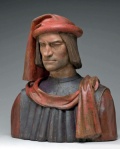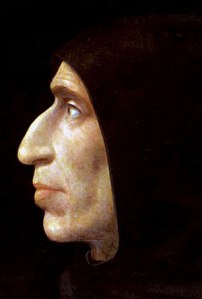
For “Paradise”… means nothing more than a most pleasant garden, abundant with all pleasing and delightful things, of trees, apples, flowers, vivid running waters, song of birds and in effect, all the amenities dreamed of by the heart of man…
Lorenzo de’ Medici
Another garden referenced in Botticelli’s Primavera is Lorenzo de’ Medici’s Sculpture Garden which was located on the Via Larga facing the left side of the church of San Marco. The San Marco had an extensive orange orchard to the rear of the church in view of Lorenzo’s garden which may, in this scenario, be recognised as the oranges depicted in the Primavera. The location of the church of San Marco, placed in a corner of the piazza named after it, is another parameter for identifying Lorenzo de’ Medici’s garden in the painting.

The church, which also served as a convent, belonged to a community of observant Dominicans, a religious preaching order founded by St Dominic. If one looks to the bottom right corner of the painting, a silhouette of a monk or friar’s cowl is shaped between the legs of Chloris who can also identified as Fioretta Gorini. When rotated 90 degrees anti-clockwise, the cowl takes on the appearance of a dog’s head.

The dog motif became associated with the Order when Dominic’s name was punned as Domini canes, meaning “Hounds of the Lord”. The Order explains the “hounds” relate to the story of Dominic’s mother who, when pregnant, had a vision of a black and white dog carrying a torch in its mouth. Wherever the dog went it set fire to the earth. The dream was understood later when Dominic and his followers, clad in black and white, set fire to the earth with the Gospel message. Observe the hem of Chloris’s smokey, diaphanous dress representing the flame.
This section of the painting is seemingly prophetic in itself for it also serves another interpretation connected to Greek mythology and the “hell-hound” Cerberus that guards the entrance to the underworld. Now the hem takes on the shape of a serpent and its temptation role in the Garden of Eden.

Girolamo Savonarola (right), the Dominican friar who was assigned to Florence in 1490, and who preached and prophesied from the pulpit of San Marco that the “Sword of the Lord” would soon fall on the earth, was himself consumed by fire in 1498 when he was hanged alongside two other Dominican friars. He had confessed to succumbing to temptation and inventing his visions and prophecies. For misleading the people in this way he was excommunicated by the Church as a heretic and schismatic, and sentenced to death by the civil authorities.
So having referenced two markers in the Primavera – the orange orchard and the corner position of San Marco with its Dominican connection – a third indicator which alludes to Lorenzo’s Sculpture Garden is the statuesque appearance of the line of figures.

A fourth indicator is the patterned tunic of Mars, also identified in a previous post as Lorenzo de Medici reaching up to disperse the threatening rain cloud. The pattern represents roots, and with the figure’s feet shown firmly “planted” on the ground, Botticelli has embedded enough clues to confirm that the garden scene was intended to be recognised as Lorenzo’s Sculpture Garden as well as the those previously mentioned. But there are more which I shall reveal at another time.
The plan below, produced a century after Botticelli painted the Primavera, shows the San Marco and its extended orange orchard. The green areas indicate what remained of Lorenzo’s Sculpture Garden.


You must be logged in to post a comment.